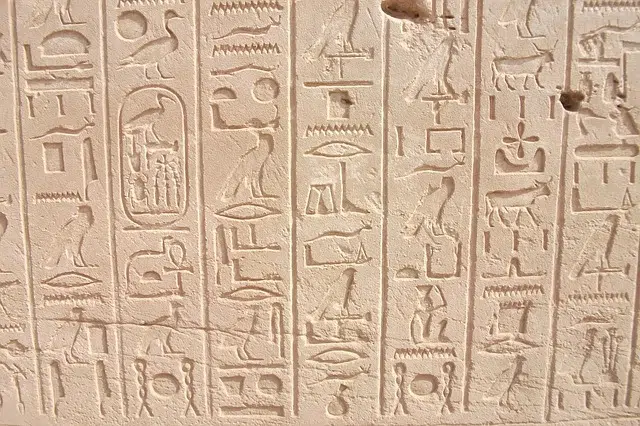
A hieroglyph is a writing system based on figures and symbols.
A hieroglyph is a type of writing in which words are not represented with alphabetic or phonetic signs, but rather the meaning of the words is expressed with symbols or figures . The Egyptians and other ancient people often used hieroglyphics on their monuments.
The term hieroglyph is used to name both the system and the figures or characters of this type of writing. As a system, it began to be used around the year 3,300 BC and was in force until the 3rd century .
The hieroglyphics of Ancient Egypt
In the case of the Egyptians, their hieroglyphs came to combine ideograms, consonant signs and determining signs. The symbols used were figurative as they represented recognizable things such as animals or body parts.
One of the tools that has been used to decipher the hieroglyphic system used by the Egyptians is none other than the Rosetta Stone. The French Egyptologist Jean-François de Champollion and the English scientist Thomas Young were the two people who managed to decipher this document, discovered in 1799, which was made up of three types of writing: hieroglyphic, uncial Greek and demotic.
Classification according to type
We have to emphasize the existence of various types of hieroglyphs. Thus, first of all, we find the so-called biliteral ones, which are those whose transliteration is made up of two consonants.
On the other hand, there are triliteral hieroglyphs which, as their name indicates, are those whose transliteration contains three consonants. And then there are hieroglyphics that contain more than three consonants.
Hieroglyphics were usually engraved in stone, carved in wood, or written in ink on papyrus. Its contents included religious texts, official statements or formulas for rituals, for example.

In Ancient Egypt, hieroglyphics were used.
From Egyptian hieroglyphs to the Phoenician alphabet
Some researchers believe that Egyptian hieroglyphics influenced the Phoenician alphabet, which was the source of the Hebrew, Greek, and Aramaic alphabets. These alphabets , in turn, constitute the original basis of the Latin and Cyrillic alphabets.
In addition to all the above, we must make it clear that the last document that has been discovered made with hieroglyphic writing is an inscription in the temple of Isis, in the city of Philae, and more specifically on the door of the emperor Hadrian. It is estimated that this recording was made in the year 394.
A hobby or something difficult to interpret
Modern hieroglyphs are made up of signs and figures that are used as a pastime or brain game.
The answer to a previous question is the one that is usually answered when solving the hieroglyph in question, which can also be formed by musical notes, numbers, letters, representations of objects from daily life...Among the expert principles in the realization of this type As a pastime, the figure of Pedro Ocón de Oro from Madrid stands out, who is known for having been the inventor of the word search, the quadragram or the oconogram.
A hieroglyph, on the other hand, is a writing or note that is difficult to interpret : "I don't understand the hieroglyph you left on the table for me," "I read this philosopher's texts and they seem like hieroglyphs to me," "Your handwriting is indecipherable: explain to me what." It means the hieroglyph you handed in during the last class, please .
